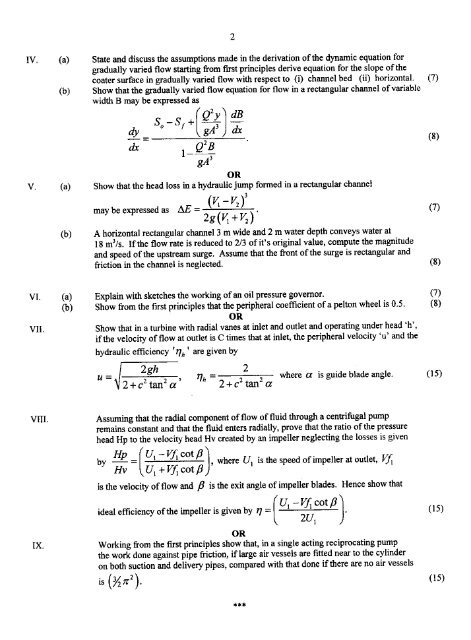Fluid Mechanics II 2010 (2006 Ad).pdf - DSpace at CUSAT
Fluid Mechanics II 2010 (2006 Ad).pdf - DSpace at CUSAT
Fluid Mechanics II 2010 (2006 Ad).pdf - DSpace at CUSAT
You also want an ePaper? Increase the reach of your titles
YUMPU automatically turns print PDFs into web optimized ePapers that Google loves.
IV. (a) St<strong>at</strong>e and discuss the assumptions made in the deriv<strong>at</strong>ion of the dynamic equ<strong>at</strong>ion for<br />
gradually varied flow starting from first principles derive equ<strong>at</strong>ion for the slope of the<br />
co<strong>at</strong>er surface in gradually varied flow with respect to (i) channel bed (ii) horizontal.<br />
(b) Show th<strong>at</strong> the gradually varied flow equ<strong>at</strong>ion for flow in a rectangular channel of variable<br />
width B may be expressed as<br />
Qty dB<br />
dY S - +(j<br />
dx<br />
dx<br />
1<br />
n2 B<br />
gie<br />
(a)<br />
OR<br />
Show th<strong>at</strong> the head loss in a hydraulic jump formed in a rectangular channel<br />
V<strong>II</strong>.<br />
(b)<br />
(vi —V2)3<br />
may be expressed as AE =<br />
2 g(V, - V2).<br />
2<br />
A horizontal rectangular channel 3 m wide and 2 m w<strong>at</strong>er depth conveys w<strong>at</strong>er <strong>at</strong><br />
18 m3/s. If the flow r<strong>at</strong>e is reduced to 2/3 of it's original value, compute the magnitude<br />
and speed of the upstream surge. Assume th<strong>at</strong> the front of the surge is rectangular and<br />
friction in the channel is neglected.<br />
(a) Explain with sketches the working of an oil pressure governor. (7)<br />
(b) Show from the first principles th<strong>at</strong> the peripheral coefficient of a pelton wheel is 0.5. (8)<br />
OR<br />
Show th<strong>at</strong> in a turbine with radial vanes <strong>at</strong> inlet and outlet and oper<strong>at</strong>ing under head 'h',<br />
if the velocity of flow <strong>at</strong> outlet is C times th<strong>at</strong> <strong>at</strong> inlet, the peripheral velocity `u' and the<br />
hydraulic efficiency 'Rh' are given by<br />
2gh 2<br />
u<br />
-<br />
2 + c 2 tan 2 a ' 2 + c 2 tan2 a<br />
where a is guide de blade angle<br />
Assuming th<strong>at</strong> the radial component of flow of fluid through a centrifugal pump<br />
remains constant and th<strong>at</strong> the fluid enters radially, prove th<strong>at</strong> the r<strong>at</strong>io of the pressure<br />
head Hp to the velocity head Hv cre<strong>at</strong>ed by an impeller neglecting the losses is given<br />
by Hp ((<strong>II</strong>—VAcot Pi , where U1 is the speed of impeller <strong>at</strong> outlet, Vf,<br />
Hv U, +Vf, cot 13<br />
is the veloety of flow and /3 is the exit angle of impeller blades. Hence show th<strong>at</strong><br />
, — Vf, cot p)<br />
ideal efficiency of the impeller is given by ri =(U.<br />
2U,<br />
OR<br />
Working from the first principles show th<strong>at</strong>, in a single acting reciproc<strong>at</strong>ing pump<br />
the work done against pipe friction, if large air vessels are fitted near to the cylinder<br />
on both suction and delivery pipes, compared with th<strong>at</strong> done if there are no air vessels<br />
is (%2 g2).<br />
***<br />
(15)<br />
(15)<br />
(15)
















